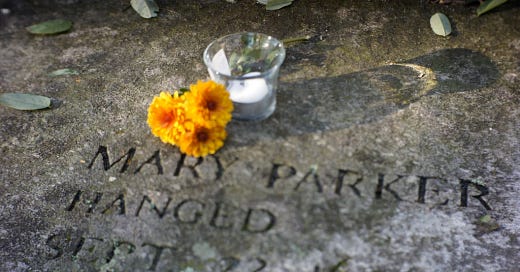the genealogy book
, Christine's connection to Mary Ayer Parker, and the infamous Salem Witch Trials,
Rabbit holes, rabbit holes. Every time I discover something new, I report to Christine, which has been occasionally prompting further of her own research. Recently this led her to the discovery of a ninth great aunt, Mary Ayer Parker (c. 1637-1692), the fifty-six year old widow executed by hanging as part of the Salem Witch Trials (1692-1693). Mary, of Andover, Massachusetts Bay Colony, was the daughter of Wiltshire, England-born John Ayer (1582-1657), one of the original European settlers in Massachusetts. John Ayer first settled in Ipswich, Massachusetts before relocating to Merrimack (later renamed Colchester, after the town in England where many of those original settlers originated) and eventually Salisbury. Given my own newly-realized wealth of early Puritan roots, our working theory is that our lines must connect along here, somewhere—my eleventh great grandparents, Nathaniel Foote (1592-1644) and Elizabeth Deming (1595-1683), for example, and theirs the oldest remaining house in Colchester—although these people, this period, hold some troubling histories. As the History of American Women blog wrote on Parker back in 2008:
Mary Ayer, daughter to John and Hannah Ayer, married Nathanial Parker. She was 55 years old and a widow in 1692. Mary was accused of witchcraft, but refused to confess during the witchcraft trials saying, “I know nothing of it, there is another woman of the same name in Andover.”
She was referring to her sister-in-law, Mary Parker, the aged and senile widow of Joseph Parker, who had a documented history of mental instability. Essex County Court records from the period show that both Joseph’s wife and his son Thomas were perceived to be mentally ill. And at the time, insanity was sometimes associated with other deviant behavior, including witchcraft.
In fact, there were not one but three other Mary Parkers in Andover. The reputation of “Mary Parker” was further tarnished by the lengthy criminal history of a fourth Mary Parker from Salem Town. Throughout the 1670s, that Mary appeared in Essex County Court a number of times for fornication offenses, child support charges, and extended indenture for having a child out of wedlock. She was a scandalous figure and undoubtedly contributed greatly to negative associations with the name Mary Parker.
A disreputable name could have been enough to kill the wrong woman, in a society where the literate were the minority, and the spoken word was the most damaging. Gossip, passed from household to household and from town to town was the most prevalent source of information. The damaged reputation of one woman could be confused with another as tales of “Goody so-and-so” filtered through the community.
William Barker Jr., who testified against Mary Ayer Parker, may have been confused as well. In his own confession, William accused a Goody Parker, but he didn’t specify which Goody Parker he meant. There was a good possibility that Barker heard gossip about one Goody Parker or the other, and the magistrates of the court issued a warrant for the arrest of Mary Ayer Parker without making sure they had the right woman.
The Salem Witch Museum website offers: “Of the forty-four Andover residents who were accused of witchcraft in 1692, three were hanged for the crime. The widow Mary (Ayer) Parker, in her mid-50s, was the only accused person from present-day North Andover to be executed.” If you wish, you can still visit the site of her house at 5 Johnson Street, North Andover, Massachusetts.
“I’m also related,” Christine texts, “to Bassetts and Willards which are all mucked up with the witch trials. Mostly in opposition though and/or victims. Messy Puritans.” Messy Puritans, indeed.





I'm also a descendant of Mary (Ayers) Parker. She's also my 9th great aunt... I'm from Obediah's line, her brother. I'd be so interested to connect with Christine about this!
So fascinating, Rob!